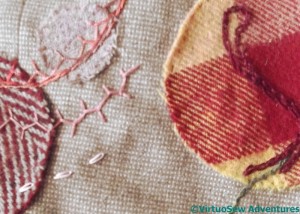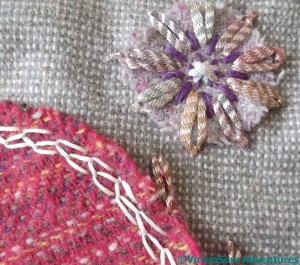Embellishing the Circles Skirt – Part One
I have two books by Edith John, “Creative Stitches” and “New Stitches for Needlecraft”, and in the latter, she in turn quotes from another book “Needlework through the Ages” by Mary Symonds and Louisa Preece, who say
“It should be remembered that it is not the stitch itself, but the manner of its use which constitutes the art of embroidery”.
I’m going to have to think about that. I think – I would like to think – that in my embroidery the “manner of use” of a stitch is an important element of my approach, but I want to think a little bit more about the How and the Why of some of my stitch choices. It might involve a little more practice stitching, but since it’s the process of stitching that appeals to me as much as the finished result, that probably won’t be a problem!
Much of Edith John’s introductory text is concerned with encouraging experimentation – not something I need much encouragement in! – but one thing she does emphasize is the delight that can be gained purely from stitchery. The whole idea of this skirt is that it should look as though I had fun with it. This is probably not a project in which the answer to Why is likely to be anything other than Because.
Some of the circles will be embroidered within their edges, some will have embroidered elements that extend beyond there edges, and some are ghost circles, linking several of the tweed circles together. In the top left corner of this first picture, you can see part of a series of concentric ghost circles, using solitary chain stitches, cretan stitch, stem stitch and half-chevron stitch.
The large checked circle is joined to a nearby one using some cable chain and twisted chain stitches, set out to suggest that the stitching is itself a stitch, running underneath the main fabric and onto the tweed.
One of the smaller circles acquired a Lazy Daisy in chainette ribbon, with a couple of falling petals on the main fabric. I’ve emphasized the centre – a circular boss using the same chainette in star stitch – using a darker stranded cotton.
I’ve learnt over the past few years that sometimes a design is best created using layers of detail. The darker stranded cotton was added after I’d done a few other circles. I came back to it, and wanted to point up the petals a little. Since the tones are all very similar, the darker thread helps. I may yet come back and add some more.
The large crimson circle is very simple at present, with a single row of closed feather stitch around the edge. That may yet change…



“… but since it’s the process of stitching that appeals to me as much as the finished result …”
I know just what you mean.
Happy New Year. I look forward to seeing the layers of detail evolve.
Ah yes, it’s the journey which matters! I do love that Lazy Daisy x
It looks already like a skirt you are having fun with! I really like the lazy daisy too.
It’s the journey that matters – as much in sewing as in life.
Your skirt’s coming on well.=)
I totally agree with that quote and not just in embroidery. I remember ten years ago when we planning a team taught Chinese class. One wanted to start with what teaching methods we wanted to use, but another thought it better to choose what material to teach and then choose the most suitable methods. So, it’s not so much a matter of getting in a certain number of stitches, or using a particular stitch, but of choosing the stitch(es) that best achieve the result we want.=)
Add oil!=)
The art of embroidery, like any art, is a process. It is not the thing that eventually results from that process. If you have fun and enjoy the process: ideas, experimenting, design, exploring, what-iffing and the physical pleasure of stitching and using materials, then that’s going to show in the result. (Sometimes this is the sort of ‘fun’ that leaves you wanting to throw the thing out of the window, or groaning as you unpick a week’s work that isn’t quite right, but that’s part of the process of learning and discovering what does and doesn’t work.) Enjoyment glows through: it gives the finished stitchery character, ‘soul’, individuality. If what you are doing excites you, you know that you’re on the right lines. I’m looking forward to see what else you get up to on your quirky circles skirt.
I love the process but I also just like to suspend all the thinking and bath in the joy of stitching.
Process is important – I think it is in the process that the relationship between fabric, thread and stitch reveals itself – a bit like when in the process of writing we understand the topic better.
The detached chain stitch looks pretty with the chainette ribbon.I totally agree that the process of stitching is the most appealing part. But ‘the how and why’is also important to a certain extent I think. Looks like you are having fun already..looking forward to see more of this progress.
I love what you’re doing, but more than that the ‘manner’ in which you’re doing it. Experimenting, studying stitches, letting the circle design dictate some of what you do but then going ‘out of the line’. A beautiful post!
wonderful quote….I couldn’t agree more.
Your work reminded me of Sue Spargo – she does the most amazing work on wool fabrics.
This is the link for her blog http://www.suespargo.com/weblog2/
It looks like it’s a lot of fun to stitch – in addition to the comments about the art being in the process above.
I really love the daisy. So cute, I could have a whole skirt full of those! 🙂
[…] Hungarian Braided Chain, and I found it in one of those books by Edith John that I mentioned when I began embellishing the Circles Skirt. If you think of it as Heavy Chain with the needle weaving over and under the threads as shown […]